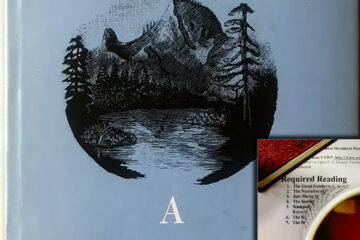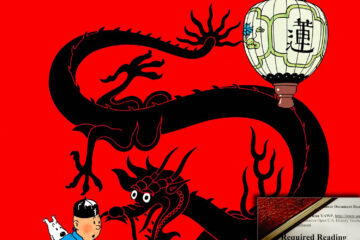One of Mike Burns’ favorites, this painting is shown during schola brevis (the first day of the course), to start the critical thinking of the students. Posing questions like:
Why do you see?
Why are the colors important?
What would you title this piece?
What is missing (assume nothing is accidental, this is art after all)?
“State Names” by Bell McKee
A member of the Confederated Salish and Kootenai Tribes of the Flathead Nation in Montana, Jaune Quick-to-See is a Native American artist. In her piece “State Names” she attempts to draw awareness for Native people and their art as well as their struggles. The piece includes newspaper clippings from the New York Times and her reserve’s paper, the Char-Koosta. Jaune Quick-to-See carefully crafted and selected which states she would include. Jaune Quick-to-See Smith concluded that all states whose names have origins linked back to Native groups from those states. For example, Kansas is a Sioux word that means “people of the south.”
As a work of art, it radiates a clear sorrowful, disconnected, and almost decaying feel. By utilizing black for large bodies of water such as the Atlantic and Pacific Oceans flanking the United States continent, Jaune Quick-to-See Smith communicates a “cut-off” feel from the rest of the world. Smith then continues to carefully select a color palette. The colors she utilizes are reminiscent of rust and help to demonstrate an aged feeling. Smith allowed her paint to drip down, blocking out state lines and making them murky. This “blending” of sorts signifies two things. It shows how the tribes did not possess the set, “state” lines the Europeans would later establish. The natives lived based on what tribe was where more so than designating certain areas to certain groups. This “state drawing” by Europeans connects to the European’s idea of entitlement to their new-found land without regard for its current owners. It also presents the fading of these tribes as they have been disregarded a vast majority of history. This European disregard for the Native people was felt by the relocation of tribes onto federal reserves, especially as those reserves become smaller and fewer.
Jaune Quick-to-See Smith did an extraordinary job with this large-scale piece and there are many aspects for its viewers to enjoy. Smith speaks strongly and clearly in her art for those she loves.
“State Names” by Grayson Rogers
The oil painting, State Names, by Jaune Quick-to-see Smith can be found in the Smithsonian American Art Museum located in Washington, D.C., and the piece has been there since the year 2000. Through the blurred state lines, labeling of only a select few states, and other abnormal features seen, this piece has many ways it could be interpreted, helping it to be a piece that contains a much deeper meaning than just what meets the eye when you first glance at it. It represents a change in power, a change in presence, and a change in the way the world was functioning at a very influential period in history.
One of the most prominent features of this piece that immediately jumps off the canvas when you first look at it is the paint running down through the entirety of the canvas, leading to many blurred state lines and borders on the map. This can be interpreted as a representation of the many different settlers, tribes, and other groups that had conflicts over property and land, making the line illustrating boundaries of the different territories unknown or blurry, as seen in the painting.
Another abnormal characteristic of the painting is the labeling of certain states and lack thereof for others. Immediately after looking at the painting, it becomes clear that only about half of the states are labeled, majority of them being midwestern states, such as Nebraska and Wisconsin. The select few labeled states represent states that were home to Native Americans before their territories were taken or changed by the arrival of many European settlers and other groups coming to the Americas. This is a simple way to represent a major shift in authority and power in the Americas when many Europeans arrived. Almost instantly upon arrival, the Europeans sought to take everything they wanted, with land being one of those major wants.
Today, this piece can serve as a reminder of the immense change that has happened in terms of both land property size for many groups of people, in particular the Natives, and the presence that the Natives used to have throughout much of the United States. This piece shows us just how much many things can change over time, and serves as a reminder that any given group’s control over anything can change in one instant.
State Names by Matt Monarchik
This painting by Jaune Quick-To-See Smith is called State Names. State Names was painted in 2000 and consists of oil, collage and mixed media on canvas. As you look closer at the painting, it is missing a few state’s names even though it is called State Names. Along the coastline, it is just colors without the names of the states, but as you move away from the coastlines the names of the states begin to be included. Behind the names, there are colors that bleed from state to state across the boundaries.
When I looked deeply into why some of the states were missing their names, I realized that it represents what land the English began taking away from the Native Americans. State Names shows the pain and suffering that the native Americans were put through. That still leaves people wondering why their names are in the middle. If you analyze the names closely, you will notice that the remaining names that are left derive from some type of Native American word. This is ironic because as the English were invading the Native’s land we then started to name our states with words that trace back to Native American words such as Delaware and Kansas.
Another way that this painting is portrayed is by using paint smears. When you look at the paint smears, I believe that it represents how America is connected. For example a major issue in Georgia is going to spread down to Florida and in Alabama due to the various news media that exist today. Another way in which the smears can be described is by tears. Due to the English colonization, it displaced many Native Americans. This leads to rebellions that lead to death which is represented by the sad appearance that the smears give to the map.
Jack Winters
The image looks as if America is somewhat bleeding or dripping away. It seems like it is giving off a negative connotation or feeling. It is a blend of many different paint colors and for some reason, the oceans are painted black. A few states have two colors but most of them are one color and blend down with the other states. The color red is in a few states and seems like it has a meaning behind it. There is a reason why not all of the states are labeled.
The artist of this painting, Jaune Quick-To-See Smith, meant for this image to represent the states that connect with the indigenous people and tribes. The layers of paint blending represent the passing of time and show highlights of the lives of Native Americans. Smith works with two Confederated tribes and seeks to raise awareness for the Native American art and people. She believes that we own this country and part of it has been stolen by invaders of America. Smith sees this as a way to display her anger that our land has been divided “without regard for existing tribal territories.”
You can interpret this image in many different ways because that is what art is made for. I don’t look at this picture and see anger about our land, while others may see that. Art has so many meanings, and there is no correct meaning for this piece of work. This painting looks like a country that is falling apart and dripping in tears because of a crash or bad time for the economy. The dripping effect makes it seem like it is a droopy country with not much life and good things around. All in all, this painting by Juane Smith can be looked at many different ways and still have a strong message from the artist.
State Names by Caitlin Mohrman
In the year 2000, a Native American named Jaune Quick-To-See Smith created an art piece called State Names. This piece is a drawing of the United States where many colors seem to be “dripping” over each other. Even though the title of this piece is called State Names, some names are missing. Smith created this piece to express her feeling of injustice that was shown to the Native Americans and wanted to highlight the culture and influence that the Natives had on America.
In the picture, you can see that some states are not labeled, because those states were named after or by Englishmen. One of the states that is not labeled is Virginia, which was named after Queen Elizabeth the “Virgin Queen.” These states are not labeled because Smith wanted to draw attention to the states that are named like Arizona and Tennessee. The states that are labeled were inhabited by Native Americans and are all related to the Indians in someway. Smith wanted to show the influence that the Indians had on America that can still be seen today. In this
painting, I can see that the influence is drifting away, due to all the colors dripping over the other. Smith also wanted to educate people about the culture of Indians, and that their culture is all around us.
When looking at the painting State Names, it makes people question what the artist is trying to portray. This leads to curiosity and questioning, that leads people to want to understand more about what this piece is and what it is trying to portray. When someone finds out about what it means, they will be educated exactly how Smith wanted. This is exactly what Smith wanted when she created the painting. When looking at this painting, I interpreted it as all the states blending into what we know as the United States. When learning about the meaning of the painting, I would’ve never seen that. As I now know, I can understand the deeper meaning that Smith wanted. The injustice that Smith also wanted to express though this painting can be seen everywhere. Most paintings have a history and a deep meaning that cannot be seen by just a quick glance, which can be seen in this painting.


